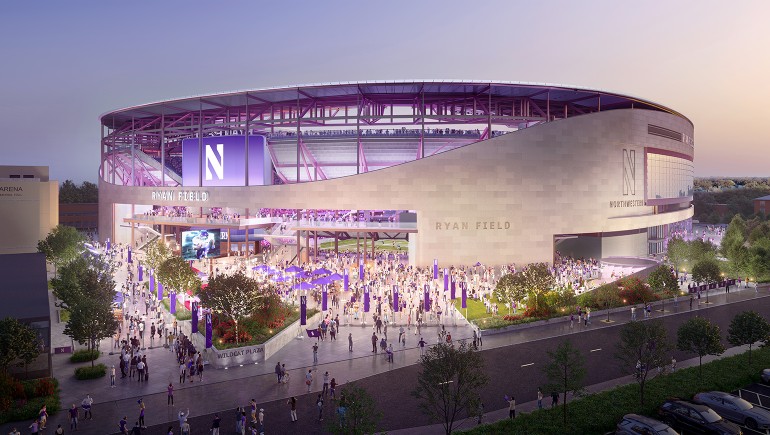
Northwestern University unveiled an ambitious new Ryan Field development plan, tearing down the existing 97-year-old stadium and replacing it with a privately financed stadium under a new $800-million plan.
Though Northwestern University has been engaged in fundraising for a new stadium, the gift of $480 million from the Patrick and Shirley Ryan Family put the effort over the top.
Under the plan, the existing Ryan Field would torn down in 2023 while work commences on the replacement Ryan Field, which would open in 2026. The proposed new Ryan Field would be smaller, swankier and neighborhood-friendly than the existing Ryan Field. Proposed design highlights include:
- A more intimate setting, designed for a maximum capacity of 35,000, more than 12,000 fewer than the current Ryan Field, with a state-of-the-art canopy designed to focus noise and light on the field.
- New community assets: The new Ryan Field is being developed as a modern stadium campus with beautiful plazas, an exceptional new community park as well as other publicly accessible greenspaces for residents to enjoy year-round community activities.
- Accessibility: The new stadium will apply Universal Design standards, making it among the most accessible stadiums in the country (an example is shown below).
- Sustainability: The project is designed to achieve Gold LEED certification.

The proposed design is billed at providing the best sight lines in college football and offering a premium experience, including chair backs to replace bleachers, for every fan as well as an innovative student section (maybe safe seating a la soccer?); new cutting-edge technology and scoreboards; upgraded concessions featuring food from local restaurants; and iconic design features inside and out, according to a Northwestern press release.
“We are extremely excited to move forward with a transformational stadium project and grateful to our University leadership and to the Board of Trustees for their decision to take the next steps toward a new Ryan Field,” said Dr. Derrick Gragg, Combe Family Vice President for Athletics and Recreation, via press release. “We are all grateful to the Ryan Family for their unwavering commitment to Northwestern University and our academic and athletics programs. I have no doubt that the privately funded stadium will be a gamechanger for our football program, athletics department and the community, and will be in line with our other excellent facilities including Welsh-Ryan Arena and Ryan Fieldhouse.”

The Ryan Family’s gift was the largest in Northwestern history, and included funding not only for the new stadium, but the largest academic gifts in the history of Northwestern to accelerate breakthroughs in biomedical, economics and business research. The gift, which the Ryan Family has now committed to increase, ensures the new Ryan Field and plazas will not come at the cost of research, scholarship, student aid, tuition or staff and faculty support.
“Our family’s commitment to athletics is much deeper than football. It’s about developing the body, mind and soul, which we experienced as undergraduates at Northwestern and have carried with us throughout our lives,” Pat Ryan said via press release. “The new Ryan Field will be more than just an amazing home for Wildcat football. Our hope is that through this new stadium campus, Ryan Field is reimagined as an architecturally significant year-round gathering place for the Northwestern and Evanston communities that is accessible to all.”
The design comes after meetings with stadium neighbor to bring in community feedback, including formal sessions with the 7th Ward Working Group, led by Evanston Councilmember Eleanor Revelle. Based on that feedback, the initial design concept includes:
- Plans to reduce vehicular traffic when the stadium is in use. Some concepts under consideration include:
- A complimentary bike valet program, to promote safe cycling while improving traffic flow and provide safe bike storage during game days;
- A capacity reduction of 12,000 fans;
- Initiating conversations with Metra, CTA and ride-sharing services to explore more efficient scheduling and availability on game days;
- A modern design that will reduce noise and light pollution. That includes an extended canopy, as shown in the rendering below.
- Designing an underground loading and service dock, away from the sight lines of nearby residents and businesses.
- A year-round facility that will further promote community engagement and offer opportunities for Evanston and local non-profit organizations.

Also on tap: concerts. There are no specific plans for a number of concerts; this is more a financial concern than anything concrete as of now. Preliminary market studies indicate that the current interest in concerts in the area could generate over $35 million in new tax revenue for the City of Evanston from Northwestern over the first decade of the new Ryan Field alone.
These renderings are preliminary, and there are plenty of details to be filled in, including where the Wildcats will play during construction of the new stadium. The logical solution would be Soldier Field. There will be some sentimental arguments for Wrigley Field, but with the MLB season running through the end of September, it doesn’t to be a practical argument.
